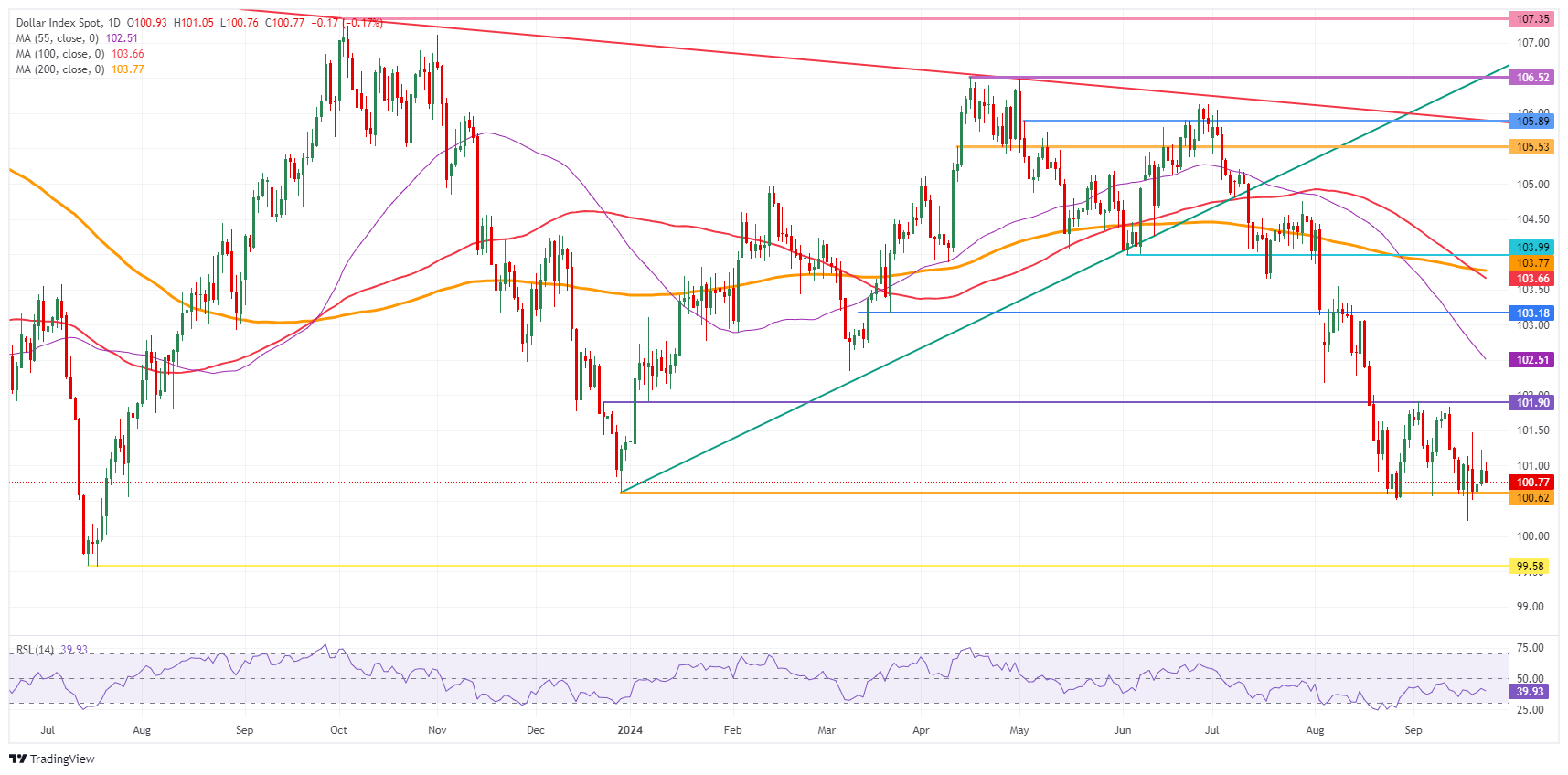- The US Dollar trades lower in the US trading session on softer US data.
- US equities are giving up earlier gains and are turning red after the US data.
- The US Dollar Index breaks out of its September bandwidth and dips lower again.
The US Dollar (USD) eases on Tuesday after the start of the US trading session. Main driver for the downturn comes after both the Consumer Confidence for September and the Richmond Fed Manufacturing Index for September both are coming in lower than expected. The softer numbers are supportive for another big rate cut for the upcoming US Federal Reserve meeting in November.
On the economic data front, all is done and dusted with markets now looking forward towards Wednesday with New Home Sales for August. Main pivotal point this week will rather be Thursday with Durable Goods and the US Gross Domestic Product release. For that same Thursday, Fed Chairman Jerome Powell is expected to make some comments as well.
Daily digest market movers: Data driven means volatility
- On the geopolitical front, a United Nations emergency meeting is called on Tuesday for Lebanon after intense bombing over the weekend and on Monday by Israel.
- This Tuesday Federal Reserve Governor Michelle Bowman left a few comments for the markets to digest:
- Fed Bowman said that there are still more jobs than people looking for one.
- The Fed should keep its eye on inflation with upside risk still at hand.
- At that same time, the Housing Price Index for July came in at 0.1%, a touch softer than the expected 0.2% forecasted.
- At 14:00 GMT, the Richmond Fed Manufacturing Index for September came in at -21, a downside surprise after a -17 was expected, higher than the previous -19.
- At the same time, the Consumer Confidence reading came in as well as a downside suprise by falling to 98.7, far from the expected 104.0, and worse than the 103.3 previously.
- Equity markets are reversing in the US and are giving up earlier gains that got made on the back of that Chinese stimulus news. US equities dip lower and are down by nearly 0.25% for all three major averages.
- The CME Fedwatch Tool shows a 48.5% chance of a 25-basis-point rate cut at the next Fed meeting on November 7, while 51.5% is pricing in another 50-basis-point rate cut.
- The US 10-year benchmark rate trades at 3.75%, and retreats from its September high.
US Dollar Index Technical Analysis: DXY breaks out lower
The US Dollar Index (DXY) looks a bit stuck, broken even, and locked in again in that September tight range near the yearly lows. When looking at the yields and the interest rate differentials between the US and other countries, it does not look to add up that the US Dollar is where it is at the moment. Traders are awaiting more data to assess where the US Dollar Index needs to go and commit to a certain trend.
The upper level of the September range remains at 101.90. Further up, the index could go to 103.18, with the 55-day Simple Moving Average (SMA) at 102.51 along the way. The next tranche up is very misty, with the 100-day SMA at 103.66 and the 200-day SMA at 103.77, just ahead of the big 104.00 round level.
On the downside, 100.62 (the low from December 28, 2023) is the first support, and a break could point to more weakness ahead. Should that take place, the low from July 14, 2023, at 99.58, will be the next level to look out for. If that level gives way, early levels from 2023 are coming in near 97.73.
US Dollar Index: Daily Chart
Employment FAQs
Labor market conditions are a key element in assessing the health of an economy and thus a key driver for currency valuation. High employment, or low unemployment, has positive implications for consumer spending and economic growth, boosting the value of the local currency. Moreover, a very tight labor market – a situation in which there is a shortage of workers to fill open positions – can also have implications on inflation levels because low labor supply and high demand leads to higher wages.
The pace at which salaries are growing in an economy is key for policymakers. High wage growth means that households have more money to spend, usually leading to price increases in consumer goods. In contrast to more volatile sources of inflation such as energy prices, wage growth is seen as a key component of underlying and persisting inflation as salary increases are unlikely to be undone. Central banks around the world pay close attention to wage growth data when deciding on monetary policy.
The weight that each central bank assigns to labor market conditions depends on its objectives. Some central banks explicitly have mandates related to the labor market beyond controlling inflation levels. The US Federal Reserve (Fed), for example, has the dual mandate of promoting maximum employment and stable prices. Meanwhile, the European Central Bank’s (ECB) sole mandate is to keep inflation under control. Still, and despite whatever mandates they have, labor market conditions are an important factor for policymakers given their significance as a gauge of the health of the economy and their direct relationship to inflation.
Information on these pages contains forward-looking statements that involve risks and uncertainties. Markets and instruments profiled on this page are for informational purposes only and should not in any way come across as a recommendation to buy or sell in these assets. You should do your own thorough research before making any investment decisions. FXStreet does not in any way guarantee that this information is free from mistakes, errors, or material misstatements. It also does not guarantee that this information is of a timely nature. Investing in Open Markets involves a great deal of risk, including the loss of all or a portion of your investment, as well as emotional distress. All risks, losses and costs associated with investing, including total loss of principal, are your responsibility. The views and opinions expressed in this article are those of the authors and do not necessarily reflect the official policy or position of FXStreet nor its advertisers. The author will not be held responsible for information that is found at the end of links posted on this page.
If not otherwise explicitly mentioned in the body of the article, at the time of writing, the author has no position in any stock mentioned in this article and no business relationship with any company mentioned. The author has not received compensation for writing this article, other than from FXStreet.
FXStreet and the author do not provide personalized recommendations. The author makes no representations as to the accuracy, completeness, or suitability of this information. FXStreet and the author will not be liable for any errors, omissions or any losses, injuries or damages arising from this information and its display or use. Errors and omissions excepted.
The author and FXStreet are not registered investment advisors and nothing in this article is intended to be investment advice.
Recommended content
Editors’ Picks

EUR/USD holds gains above 1.0800 after EU inflation data
EUR/USD is holding gains above 1.0800 in the European session on Tuesday after the mixed Eurozone inflation data. The pair is driven by renewed US Dollar weakness as attention turns toward the US jobs survey and ISM PMI data amid looming Trump's reciprocal tariffs.

GBP/USD turns higher above 1.2900 ahead of US data, tariffs
GBP/USD has regained upside traction above 1.2900 in Tuesday's European trading. A fresh round of US Dollar selling lift the pair ahead of the top-tier US economic data releases and Wednesday's tariffs announcements.

Gold price hits new all-time high ahead of Trump’s reciprocal tariffs
Gold price edges higher again for a second day this week and for the first day of the second quarter of 2025. The precious metal trades slightly above $3,130 at the time of writing and the new all-time high was eked out at $3,149 this Tuesday.

JOLTS job openings set to decline modestly in February
The Job Openings and Labor Turnover Survey (JOLTS) will be released on Tuesday by the United States Bureau of Labor Statistics. Markets expect job openings to decline to 7.63 million on the last business day of February.

Is the US economy headed for a recession?
Leading economists say a recession is more likely than originally expected. With new tariffs set to be launched on April 2, investors and economists are growing more concerned about an economic slowdown or recession.

The Best brokers to trade EUR/USD
SPONSORED Discover the top brokers for trading EUR/USD in 2025. Our list features brokers with competitive spreads, fast execution, and powerful platforms. Whether you're a beginner or an expert, find the right partner to navigate the dynamic Forex market.


